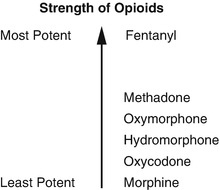Drug
Strength relative to morphine
Usual starting oral dose (mg)
Dosing interval (h)
Onset (min)
Morphine
1
10–30
IR: 3–4
30–45
ER: 12
Hydromorphone
5
2–4
4–6
30
Oxycodone
1.5–2
5–15
4–6
30–60
Methadone
7.5
2.5–10
8–12
60–90
Oxymorphone
7
5
12
30–60
Table 30.2
Bioavailability, half-life, and duration of commonly used opioid analgesics
Drug | Bioavailability-oral (%) | Half-life (h) | Duration (h) |
|---|---|---|---|
Morphine | 30–40 | 2–4 | 3–4 |
Hydromorphone | 25 | 2–3 | 2–3 |
Oxycodone | 60–80 | 3–4 | 4–6 |
Methadone | 80 | 22 | 6–12 |
Oxymorphone | 10 | 6–8 | 3–4 |

Fig. 30.1
Strength of opioids
Oxycodone is predominantly a pro-drug and undergoes hepatic metabolism via cytochrome P450 2D6 enzyme, where it is converted to oxymorphone, an active metabolite with mu opioid agonist properties, and noroxycodone, an inactive metabolite. The kidneys excrete oxycodone; therefore , the dose should be adjusted in renal dysfunction.
Oxymorphone
Oxymorphone is a semi-synthetic opioid that has been available as an oral formulation since 2006. Oxymorphone is primarily a mu opioid receptor agonist that has more affinity for the mu opioid receptor than morphine and is ten times as potent as morphine when given IV. Oxymorphone has greater affinity for the delta receptor, with agonism decreasing tolerance, and less affinity for the kappa opioid receptor unlike oxycodone. Like fentanyl, oxymorphone has less histamine release from mast cells than morphine and is more lipid soluble than morphine and oxycodone. The increase in lipophilicity leads to maximum plasma concentrations in 30 min as compared to morphine IR in 1.2 h.
Oxymorphone’s bioavailability is only 10%, due to extensive first-pass hepatic metabolism; however, greater lipid solubility facilitates its ability to cross the blood brain barrier (BBB) and may account for its rapid onset of analgesia. For immediate release (IR) formulations, onset of analgesia is 30–60 min, with predictable dosing. For extended or sustained release (ER/SR) formulations, steady state occurs in 3 days with every 12 h dosing.

Full access? Get Clinical Tree





